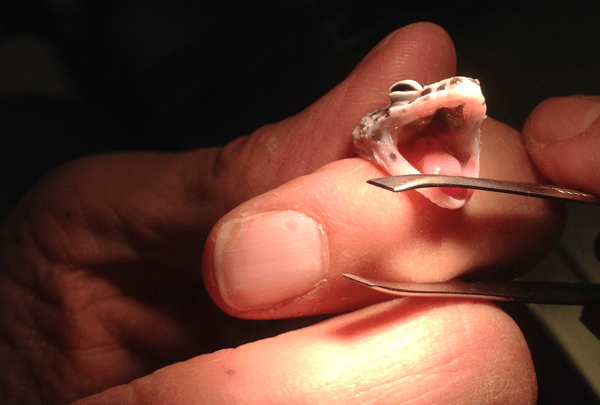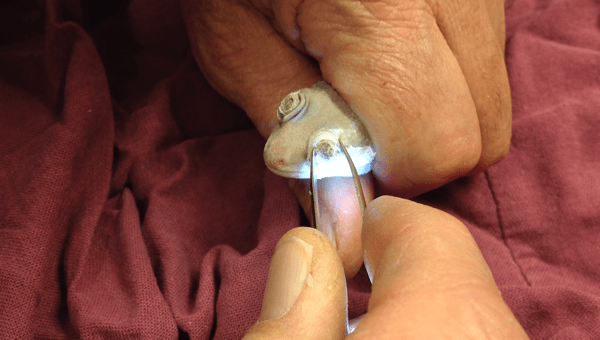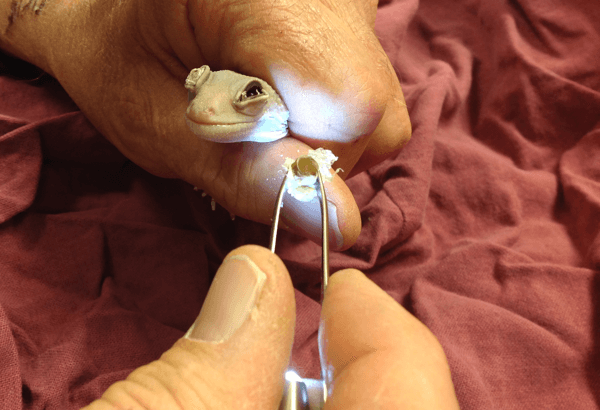I have never had a gecko as a pet. And that is an important fact in my suggestions for their care. My perspective is as if I am a space alien looking down on Earth from Mars and telling us we need to clean up our atmosphere. I do see hundreds of geckos each year with multiple kinds of veterinary problems. I have been treating geckoes for more than twenty-five years and my care suggestions spring from two generalized observations.
The first is that gecko owners come in two flavors: aficionados and starter-pet owners. So right off the bat, in a forum like this, I may be talking to the wrong crowd. But wait a minute, hear me out.

Identifying the Problem
There is a bit of trickle down, and in this case trickle up, confusion from the starter-pet crowd to the aficionados about one of the problems that I now see constantly in leopard geckos. It is what I call “eyelid dysecdysis”. This is where the eyes become so loaded with gunk, shed and goo that the eyes crust over and the gecko can’t see.
The mechanics of this problem arise from the fact that leopard geckos have crinkled eyelids. If you trace the eyelid from bottom, (or top), to eye surface, it takes about three acute angle turns, curving into the wet part of the eyelid. Because of all these turns it makes it hard for the shed skin to peel off easily. Any stickiness at the wet eye surface glues it on.
Twenty-five years ago I rarely if ever saw this disease. Once a year at most. Now I see it daily. It is part and parcel of the usual problems like metabolic bone disease, respiratory problems, parasites, and generalized (toe) shedding problems. So what is different now from twenty-five years ago?
There are several things. One is that leopard geckos are way more popular than they were. That means that the kinds of people bringing leopard geckos to the veterinarian are different. Back then it was the aficionado. Now it is parents with kids in tow who are being taught responsibility. It is not so much about passion as it is compassion.
Proper care is taught by book, internet or the pet store. Proper care is implemented not sensed: Care is often based on what people have read on the internet or been told . Most new gecko keepers have not had enough experience to sense whether their care protocols are working.

Is this wrong? No, because this is how people and especially kids connect to wild nature in today’s world. Should this be done on the backs of geckos? No, so proper care is written about, talked about, and disseminated through discussions, veterinary appointments, forums and magazine articles.
So what is really different from twenty-five years ago? Temperature and light seem to me to be the primary variables. Not food, or vitamins or minerals. Not new or emerging parasites or infectious diseases.
There has been a big push in the world of reptile care to get the temperature up and to get the lights right to prevent metabolic bone disease, to promote proper digestion, and to simulate natural environments. These factors are harped on. As a result, this has raised the general ambient temperatures of geckos in care. What I used to hear was 70’s F to low 80’s F. Now I hear 80’s F and 90’s F at floor level basking and hot spots. I never used to hear about basking and hot spots. People are so worried about having the right lights and heat for fear of doing something wrong that they are not tapped into what is really going on biologically with the animal. Unfortunately, starter-pet people are taught that the technology of care is way more important than the biology of care.
At our clinic, The Odd Pet Vet, people board their pet reptiles with us while they go on vacation. Some of these cages have more electricity running into them than electric pizza ovens. Lights, timers, under tank heaters, ceramic heaters, and automatic misters are attached to most set-ups. Yet many of these leopard geckos are rarely handled by their owners for fear of hurting them.
So what’s the cause of eyelid dysecdysis? Dehydration. So what are the causes of dehydration? Several things. One is that the gecko is not feeling well, or is not feeling well adapted, and is not drinking. (You can lead a horse to water but you cannot make it drink).
The main reason, in my space alien opinion, is that the heat is too high and the lights too bright. The humidity is too low.


Solving the Problem
What’s the prescription? It depends on how bad and how long the eyes have been covered. Some geckos just need a good eye rinsing and all is back to normal. Others need eye blockage removal. This can usually be done with thumb forceps and careful peeling out of the debris. Once and a great while it requires anesthesia. After that, daily eye ointments once a day for at least thirty days is required. I usually use triple antibiotics or gentamicin ophthalmic ointments. Ointments, not drops. The ointment stays put on the eye surface long enough to be effective. I do not worry about the topical use of gentamicin. (Internal use of gentamicin will kill your gecko dead as a door nail and faster than a speeding bullet).
I also put these geckos on TMS antibiotic at the same time. (TMS is sulfamethoxazole and trimethoprim pediatric suspension mix). I use it at a strength of 30 mg/kg once a day or every other day depending upon how damaged the local skin and general condition of the animal is. I also deworm, even if we don’t have a fecal sample to analyze. Remember, we want these guys to drink and feeling well is the best advocate for drinking.
What’s the prevention? Soaking. Twice a week in warm, knee-deep (gecko knees) water for 15-20 minutes. For the anti-soaking crowd, remember, I am not talking to you, but to the average starter-pet owner. Gently dry them off with a paper towel when you are done.
Why do I recommend this and not better moisture, better water dishes, humidity hides, and more natural solutions? Because I think it is important that starter-pet owners pick their animal up and put it in a water container that has knee-deep (remember, gecko knees), warm water in it. This does several things. It makes gecko owners more aware of their pet. They see the gecko, feel the gecko and see whether their gecko is urinating and defecating (right in the water). Some water gets absorbed by the skin (not much), and geckos will drink when they are in the water. Angry geckos probably drink more than placid I-like-baths geckos.
Stories back to me by clients about geckos who have had this disease and have lowered total cage temperature and have started bathing regularly are success stories. It’s like we’re back in the 1990’s all over again.
So is this disease caused by too little Vitamin A? That’s what I hear. It’s not what I believe. Could it contribute? Maybe. I am sure that a cure, nor prevention, will not be effected by simple Vitamin A increases.
En Guarde 🙂 Greg Mertz–The Cold-Blooded Vet


What a great article! Also a good reminder that these guys need some coolness and moisture to be healthy, even the species that live in arid environments.
Thanks!
Great article! I will definitely keep this bookmarked in my file of gecko health articles for future reference. It really shows how improper husbandry can effect a gecko’s health in an unexpected way.
awesome article!
Great article! In pet keeping we so often just do what everyone else is doing – it takes courage to take another look, think about it, and say “I think the usual way of doing things is wrong in this case”. I think it helps a lot that the author is a vet and not a gecko keeper – it gives him that “outsiders perspective” that may allow one to see some things more clearly.
HI there
I just saw my gecko’s eye is swollen (not crusted ..yet?). Not sure whats going on. I’m relatively new to owning reptiles..I’ve had this little guy for about 2 years and it was a baby sorta when I got her. Has anyone seen a swollen eyed gecko? Is it related to the problem in the article? Please help!
thanks
It would be impossible to know if the eye problem is related to the gecko without seeing the gecko (and probably being a vet as well). Often geckos get a swollen eye because a little piece of shed gets stuck in there. I would recommend gently washing the eye with some warm water and if it doesn’t get better within a few days, make an appointment for the vet because she may need some antibiotics.